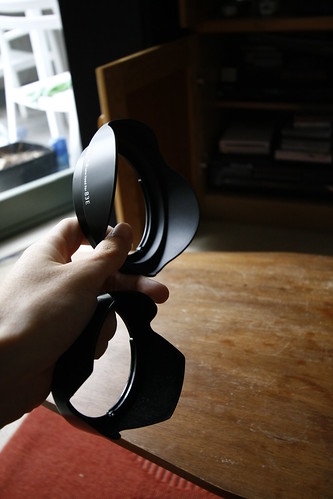I ordered one last night via a mate who’s doing an order from Adorama in the states. Can’t wait! Amateur user review will be forthcoming. :-)
Author Archives: Alex
How Flickr ranks so highly on Google
Search Engine Optimisation (SEO) is such a murky topic, I almost cringe when I hear the term. It can be used to describe legitimate techniques such as organising your website into a structure that is easy for Google to index and renaming pages to describe their contents, but also dubious methods such as paying for links from other websites and blog spam.
Flickr uses an interesting technique. Googled for “photo sharing” lately? Flickr ranks number one, above the king of search results – Wikipedia.
How did they do it? Well here’s some html code that was generated by Flickr and posted to my blog when I clicked the “Share This” link:
<div style=”float:right;margin-left:10px;margin-bottom:10px;”>
<a href=”http://www.flickr.com/photos/al40/4241715457/” title=”photo sharing”><img src=”http://farm5.static.flickr.com/4045/4241715457_b72168688f_m.jpg” alt=”” style=”border:solid 2px #000000;” /></a>
<br />
<span style=”font-size:.9em;margin-top:0;”>
<a href=”http://www.flickr.com/photos/al40/4241715457/”>Foxdown 13</a>
<br />
Originally uploaded by <a href=”http://www.flickr.com/people/al40/”>Al404</a>
</span>
</div>
test post
<br />
The interesting part – note the value of “title” inside the name tag. What possible reason, other than SEO, could Flickr have to make the title of every single shared photo titled “photo sharing”? Every time you use share a Flickr photo this way, you’re providing a link to Flickr and boosting their name against that term. While this is certainly not as dubious as other SEO techniques, it’s also not in the spirit of the title tag or the value Google is placing on it.
Unsurprisingly, a Yahoo search also shows Flickr as number one, but Bing clearly ranks pages a different way – Flickr doesn’t appear in the first page when searching for the phrase.
Holiday Snaps
The holidays are over, I’m back to work but clearly the news reporters aren’t as stuff and the TV news are full of garbage. At least there’s photo processing to keep me occupied!
Through experimentation I’ve been learning a few tricks on processing raw photos with Canon’s Digital Photo professional – I won’t make the same mistake of promising an article on using it but it’s in the back of my mind…
Anyway here are a few photographic highlights:
Third Party Lens Hoods
What’s the difference between Canon lens hoods and the third party hoods that sell for much less on auction sites such as trademe and ebay? I couldn’t find the answer to this question anywhere else, so when shopping for a hood for my Canon 10-22mm lens I decided to go for a third party hood and find out.
The genuine example I have is a Canon EW-73B lens hood. It sells for $66 NZD on photo.co.nz, whose prices are generally in line with the current retail market while not being the absolute lowest. This is an exorbitant price for what amounts to little more than a piece of plastic. The third party equivalent sells on trademe for around $25 NZD, much cheaper but hardly a bargain. So what’s the difference? Well effectively you’re paying $39 for the brand and felt on the inside of the hood. And perhaps slightly better quality plastic as well.
The third party example is an EW-83E. Ideally I’d purchase a third party EW-73B to compare, but the images online tell me enough that I don’t need to – they’re exactly the same as the EW-83E I have aside from the size and shape. Below is a picture that illustrates what I see as the major difference between third party and branded hoods:
As you can see there is a notable difference in the reflectiveness of the inside surface. Admittedly my hand in this photo is partly shielding the Canon hood, so I took another shot for the skeptics: here. But it’s not difficult to imagine how a smooth surface would reflect more light than black felt.
The question is whether this actually makes any difference to your photos. We know that light refracted in the lens can reduce colour saturation and cause flare (see the digital picture’s write-up on the use of lens hoods for more info), however answering the question of whether light reflected from the inside of the hood and then onto the lens can do the same is more difficult to answer (if anyone wants to shout me a third party EW-73B I’ll do my best to find out!).
At minimum the effect of using a third party hood should still be reduced flare and better colour saturation (vs not using any hood at all), so a photographic scenario that demonstrated a perceivable difference would probably have to be carefully designed. Maybe a flash just off the frame but pointing straight at the lens would do it.
Conclusion
Both third and first party lens hoods are a ripoff.
ThinkTank “Urban Disguise 70” Buyer Review
I’m not in the habit of reviewing everything I buy, but it does give me something to post. I picked this up from Progear in Newmarket for $219 (NZD), so it’s not a cheap bag but not absurdly expensive either. Note that I did actually purchase this with my own money and buyers are never totally impartial, but I’m certainly not being sponsored by the manufacturer/distributor/retailer either!
The last bag I bought to hold all my gear (a backpack from trademe) cost $79, so it was a cheapie but excellent value for money, more so than this (since the Urban Disguise 70 cost me 2.5x as much). This time around I wanted something that was durable, looked nice but didn’t scream “camera bag!”. And this seemed to fit the bill.
<--!more-->
First a shot of the bag and the gear I have to fit inside. It’s a fairly modest kit, small enough that I can carry everything most places:
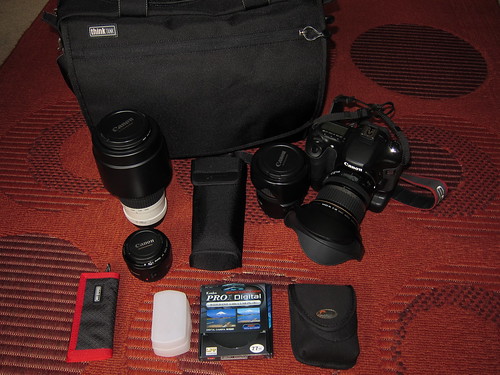
Like most bags aimed at photographers the internal layout is completely re-arrangeable, and a good number of spacers are included. This pic shows how I’ve laid out mine (albeit not very well as the zipper doesn’t allow it to open very wide):
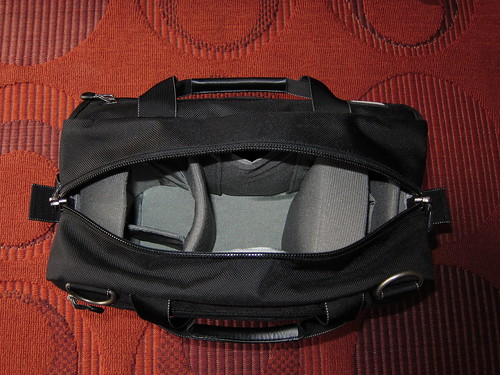
The bag has a generous number of pockets. This is one of the side pockets where I chose to store a couple of filters:

This next photo shows the pouch which holds the rain cover:
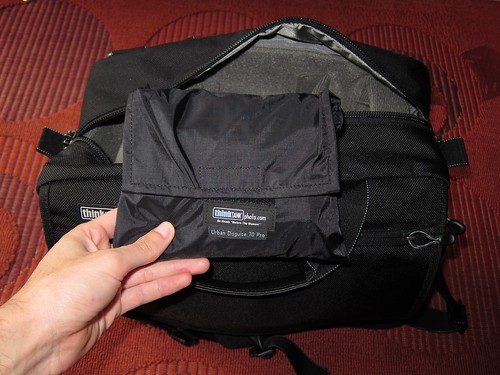
However this is one feature that I can’t really see myself using. Here’s the bag with the rain cover on:
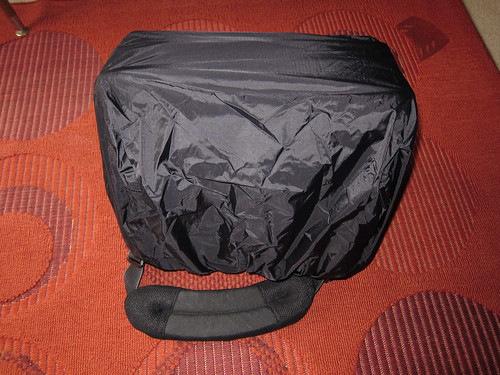
Unless you’re in the habit of leaving your camera bag outside on a rainy day, or don’t mind carrying it like a cardboard box, this is a rather useless feature in my opinion. But it does add a bullet point to the marketing materials. If I ever use it I will be sure to update the review!
Update: As noted in the comments below, you can actually use the rain cover if you attach the strap to the clips on the “back” of the bag rather than the sides. Maybe I will use it after all.
Also included is a memory card wallet which attaches to the bag via a velcro ribbon:
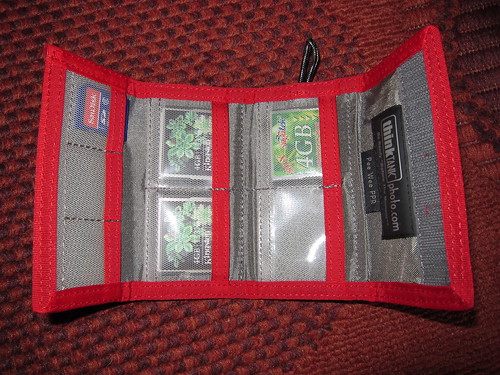
There have been a couple of times when I’ve been concerned about memory cards slipping out of my old bag, so I think this is a great idea. It’s one of those nice extra touches that really makes this a photographers bag, and wasn’t something I was expecting to find (or had even considered). It’s a shame about the gaudy colour though, and the bright blue ribbon it attaches to makes it worse (what’s wrong with gray/black?).
Finally a shot with all my gear inside:
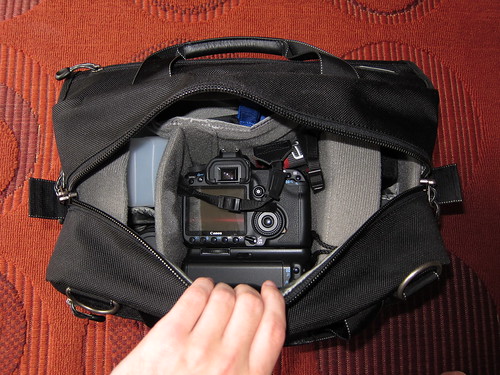
As you can see it’s a comfortable fit. The DSLR has a 10-22mm lens mounted with its hood facing outwards and there’s heaps of room. It also fits with the 70-200 on and hood reversed. I could comfortably fit another medium-large sized lens or another body, but probably not both.
You may have noticed that you can’t see much of the gear that’s either side of the DSLR (the 70-200 and flash are on the right and the 17-85 and 50 are on the left). Due to the narrow opening they aren’t that easy to access either. I could possibly remedy this by putting the DSLR on one side, but then the camera would be harder to access which somewhat defeats the point. To be fair, allowing a wider opening would compromise the look of the bag somewhat, and it’s only an inconvenience when I want to change lenses and quick access isn’t very important.
Conclusion
This is a sharp looking but understated bag that is very well made. It blends in well and is a perfect size for my needs, so I’m happy with the purchase.
Pros
- Good quality materials and construction
- Plenty of pockets and spacers
- Holds a good amount of gear
- Doesn’t look like a camera bag
Cons
- A little pricey, but not exorbitant
- Narrow zipper opening makes gear on the sides hard to access
- Rain cover has questionable utility value
- Dorky name, but it describes the mandate well
For more info see the manufacturer’s site.
Armistice Day Celebrations in Cambridge (NZ)
Over the weekend I attended a family reunion of sorts in Cambridge. Cambridge celebrates armistice day in emphatic style with a remembrance ceremony at the town hall, and a military show that runs two days.
My camera had shot over 600 frames by the end of the weekend, which left quite a few photos to sort out and process. In the end I came out with 40 decent shots.
The final set is here.
For more information about Armistice in Cambridge, visit armisticeincambridge.co.nz.
Changing compiz animations for specific windows in Linux
I use the terminal program Guake on my Ubuntu 9.10 laptop, which is really handy for quick access to a terminal window (I changed the shortcut key from F12 to Alt+~ though, which makes more sense to me as it’s more like Quake :-)).
With Desktop Effects enabled though, the default animation doesn’t quite look right. So to change it I needed to figure how to change the animation for a specific window. Fortunately the process is reasonably simple.
First you need desktop effects enabled, and the CompizConfig Settings Manager (CCSM) installed:
sudo aptitude install compizconfig-settings-manager
Next, you need to know the “class” of the window you want to change (which to confuse matters is interpreted as the “name” in compizconfig). To get the class/name, enter the following command in a terminal:
xprop | grep WM_CLASS
The cursor should change to a cross, at which point you need to click on the window. You should get something like this:

Next, open CCSM by going to System > Preferences > CompizConfig Settings Manager. Click on Animations.
To add a rule for the window you want to customise, click New, choose the effect and duration (200 is a good number). Under “Window Match”, enter the following:
(name=[WM_CLASS])
Where “[WM_CLASS]” is the first field from the xprop output gathered earlier (“guake.py” in my case). CCSM seems to only match the first value for WM_CLASS, as “Guake.py” didn’t work. Refer to the screenshot below for an example.

Finally, you need to make sure that this rule is at the top so that it matches before any other rules. Simply highlight your new rule and click the up button a few times.
Ubuntu 9.10 boot stats
Bear in mind this is alpha 6. I timed from the end of the bios loading (about 8 seconds, so it’s 46 seconds from power on to idle desktop):
0s – OS starts to boot
24s – at logon screen
38s – desktop loaded, hdd idle
This is not a fresh install as I’ve been using it for a few days, however I did stop postfix and samba from loading at boot (these aren’t installed by default anyway). I’ve also added KVM.
This is pretty impressive performance, but not enough to make sleep or hibernate redundant, and it doesn’t really blow Windows 7 out of the water either.
Specs:
- Dell E4300
- Core 2 Duo 2.26ghz
- Seagate 7200.4 500gb laptop hard drive
Bring on the SSDs – at $900 the Intel 160gb X25-M G2 is still way too expensive and would have to drop by about 60% before I’d even consider one.
Nokia N900 availability in New Zealand
So. They’re not out yet but I want one, and it doesn’t look like it’s going to be easy to get hold of one.
I enquired with a friend who’s a computer dealer this week. He has an account with a major wholesalers that distributes Nokia devices, so I figured it would be a good place to start. The reply I got back was rather interesting.
Hi Alex,
By some wondrous decision, without consultation, we are now NOT allowed to sell any product from the importer that has Cell capabilities.
We have approached the commerce commission but they are swamped with bigger matters!
Long live New Zealand’s free trade… It appears that the big brothers still run the country.
[…]
Say what?
So I decided to ask Nokia themselves. And this is the response:
Hi Alex,
I am pleased to hear of your keen interest in the Nokia N900.
At this stage, there are no updates when this phone will be launched and release in Asia Pacific, which is including New Zealand. Hence, I do apologise as I am unable to confirm if the Nokia N900 will be available for sale in New Zealand once it is launched in Asia Pacific.
Kindly be advised that all new product launches are carrier and market dependent in all countries due to the tests carried out to ensure compatibility with network and government regulations. Hence, the launch dates are still not available as it is still in tests and awaiting approval from the respective network providers and government.
As a suggestion, you can subscribe to our Nokia e-Newsletter. The e-newsletter will provide any latest updates on our products as well dates for new product launches. You may refer to the link below to register for the e-Newsletter subscription:
http://www.nokia.co.nz/subscribe
We thank you for your interest in Nokia products and hope for your continued support.
Hope the above helps to clarify your query.
Thank you for emailing Nokia Careline! Please help us serve you better by providing your valuable feedback at:
[Link removed, has UID]
Do you know you can now update your phone software at your own convenience?
Visit www.nokia.com.au/support to check if your phone model is supported and download the “Nokia Software Updater”.Kind regards,
Suba
Nokia Careline
Please contact us at 0800 665 421
www.nokia.co.nz/support
Well I’m 100% sure that no government regulations are going to get in the way of a generic HSDPA device, so in other words, they need to wait for Vodafone to test whether an HSDPA 900/2100 device will work on an HSDPA 900/2100 network.
Can’t the consumer take some responsibility here? What if we want a phone that’s not locked to a particular carrier’s network? Paying $1000+ for a phone that only works on Vodafone’s network? I don’t think so. What if we want to buy a phone at market value rather than the exorbitant markup Telecom and Vodafone put on their phones? Vodafone charges $1800 for the N97 which is close to 100% markup and totally absurd.
I’m sure the high markup is done to make the contracts which include the phone more attractive, but it completely shafts anyone that doesn’t want to be locked in.
This market needs to change. Networks are built on standards, and so long as the device is compliant with those standards there should be no need for the carrier to “approve” them and control the market. Cellular devices are not just phones anymore, they’re computers, and the market isn’t reflecting that. I think the wholesaler’s decision not to sell cellular devices to computer retailers is strongly influenced by another party – and it’s fairly obvious who this benefits (hint: not the wholesaler, consumer or computer retailer, and I’d be dubious about whether this benefits Nokia in any way).
It looks like I will have to get one from a parallel importer. But I’m not particularly happy about it.
HDD failure warning in Ubuntu Karmic (9.10)
I started to write a blog post about my backup solution, but didn’t actually finish it before this happened. I only got it running on Wednesday this week, when today my laptop (running Ubuntu 9.04) refused to boot! I was getting a lot of I/O and “DRDY ERR” error messages. The boot process mounted the drive read only, dropped me to a shell and told me to run fsck manually (not terribly helpful for inexperienced users I might add).
Anyway, instead of doing that I elected to reboot from a flash drive with 9.10 alpha6 on it, and examine the disk from a properly working system. After booting Karmic, I was greeted with the following message:

How thoughtful!
The “icon” it’s referring to is a little disk icon in the top right of the screen with an exclamation mark on it. Clicking on it brings up the new Palimpsest Disk Utility – a nice step forward from 9.04, which only included gparted. There’s not really anything wrong with gparted, but its main focus is on partitioning and it doesn’t have other disk management features such as SMART monitoring. And Palimpsest does present a nice interface:
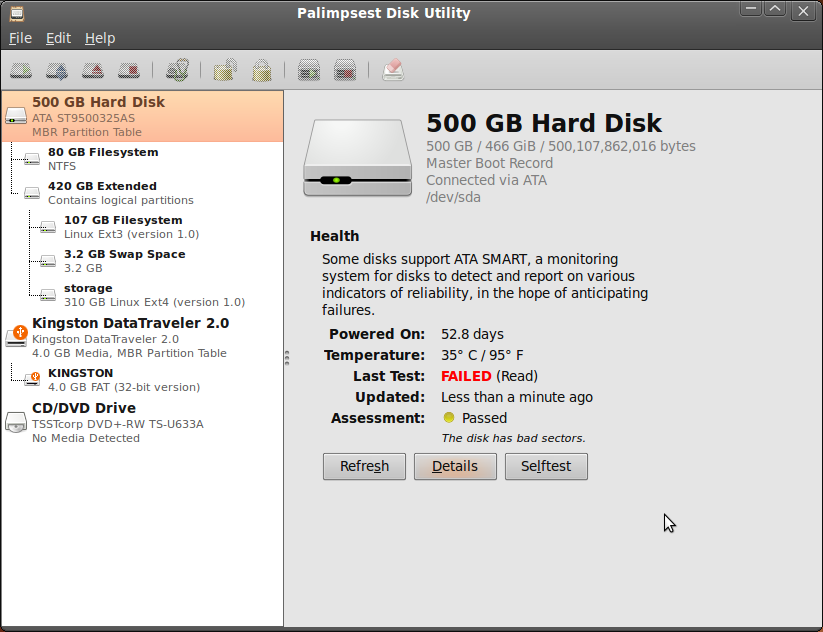
Bad sectors are not a good sign, so it would seem that this not-very-old 500gb hard drive is on the way out.
To “repair” the bad sectors (i.e. make sure the filesystem doesn’t use them), I ran “fsck -c /dev/sda5” (sda5 is my root partition, the one that was giving me trouble). This runs the filesystem check in conjunction with the badblocks tools. For now it’s up and running again, but I’ll be replacing the drive and restoring my data before sending it off for RMA!
It looks like I won’t need to go back to a backup, but this certainly shows the value of regular backups and when my laptop failed to boot I was extremely glad I had them!
Ubuntu 9.10 beta is only a week away, and so far “Karmic Koala” is shaping up to be a solid release.






